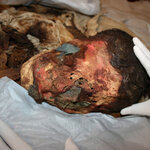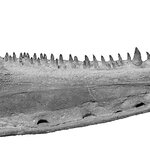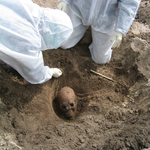Paleontology

Tulane University anthropologist Kit Nelson is the co-director of a National Geographic-sponsored team that is in the process of unraveling a mummy bundle found in Peru's historic Huaura Valley. The mummy is believed to have been an elite member of the Chancay culture, a civilization that thrived in the central coast of Peru from about 1000 to 1400 AD. The territory of the Chancay was later home to the Incas.
Nelson's work was funded by a Faculty Enhancement Grant from Tulane University and through a grant from National Geographic's Committee for Research and Exploration, a century-old body…

hominin fossils are the most important materials for exploring human origins and evolution. Since most hominin fossils are incomplete, or filled with a heavy calcified matrix, it is difficult or often impossible to reconstruct the endocast in a real fossil without destroying it.
Accordingly, traditional methods limited the study of human brain evolution. CT can explore fossils in a noninvasive way by transforming a real fossil into a virtual object, and make it possible for paleoanthropologists to extend the study of fossil specimens from the exterior to the interior.
New research, led by Wu…

Israelis and Palestinians working together? Indeed, when it comes to combating tuberculosis.
Tuberculosis - or TB - is a deadly infectious bacterial disease that usually attacks the lungs. Acknowledged as a disease of crowds, it is transmitted from human to human living in close contact.
Dating back thousands of years, tuberculosis was well known in antiquity. However, according to Spigelman, it is still the biggest killer even today. One-third of the world's current population has been infected by tuberculosis, resulting, in recent years, in approximately three million deaths per year.…

Most people who find a seashell during their summer holiday on the coast will probably not be aware that they have found a unique record of the climate. For paleontologists, those hard calcium shells provide a profound insight into the history of our earth and especially into the climate of the past.
Shells are a unique climate archive. The shells have clearly delineated growth patterns that show changing nutritional conditions, temperature fluctuations and environmental pollution. Shells are found all over the world, in the polar regions and at the equator, on land and in the ocean, in…

A new study challenges the long-held belief that diversity of marine species has been increasing continuously since the origin of animals.
An international team carried out this decade-long study and concludes that most of the diversification occurred early on – relatively speaking.
"The general understanding for many decades has been that since the rise of the modern major groups of animals about 545 million years ago (i.e., since the beginning of the Phanerozoic Era), the diversity of animal life in the seas has undergone a roughly four-fold exponential increase," says Dr. Thomas D.…

A complete mandible of Homo erectus was discovered at the Thomas I quarry in Casablanca by a French-Moroccan team co-led by Jean-Paul Raynal, CNRS senior researcher at the PACEA[1] laboratory (CNRS/Université Bordeaux 1/ Ministry of Culture and Communication). This mandible is the oldest human fossil uncovered from scientific excavations in Morocco. The discovery will help better define northern Africa's possible role in first populating southern Europe.
A Homo erectus half-jaw had already been found at the Thomas I quarry in 1969, but it was a chance discovery and therefore with no…

New exquisitely preserved fossils from Latvia cast light on a key event in our own evolutionary history, when our ancestors left the water and ventured onto land. Swedish researchers Per Ahlberg and Henning Blom from Uppsala University have reconstructed parts of the animal and explain the transformation in the new issue of Nature.
It has long been known that the first backboned land animals or "tetrapods" - the ancestors of amphibians, reptiles, birds and mammals, including ourselves - evolved from a group of fishes about 370 million years ago during the Devonian period. However, even though…

Paleontologists working in Antarctica have found fossilized burrows of tetrapods - land vertebrates with four legs or leglike appendages – dating from the Early Triassic epoch, about 245 million years ago.
The fossils were created when fine sand from an overflowing river poured into the animals' burrows and hardened into casts of the open spaces. The largest preserved piece is about 14 inches long, 6 inches wide and 3 inches deep. No animal remains were found inside the burrow casts, but the hardened sediment in each burrow preserved a track made as the animals entered and exited.
In addition…

Analysis of DNA from the remains of ancient humans provides valuable insights into such important questions as the origin of genetic diseases, migration patterns of our forefathers and tribal and family patterns.
Unfortunately, severe problems connected with the retrieval and analysis of DNA from ancient organisms (like the scarcity of intact molecules) are further aggravated in the case of ancient humans. This is because of the great risk of contamination with abundant DNA from modern humans. Humans, then, are involved at all steps, from excavation to laboratory analyses. This means that…

New research into gigantic flying reptiles has found that they weren’t all gull-like predators grabbing fish from the water but that some were strongly adapted for life on the ground.
Pterosaurs lived during the age of dinosaurs 230 to 65 million years ago. A new study by researchers at the University of Portsmouth on one particular type of pterosaur, the azhdarchids, claims they were more likely to stalk animals on foot than to fly.
Until now virtually all pterosaurs have been imagined by palaeontologists to have lived like modern seabirds: as gull- or pelican-like predators that flew over…